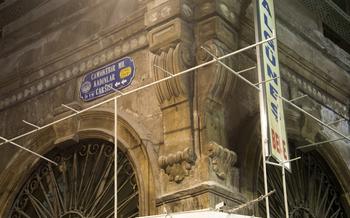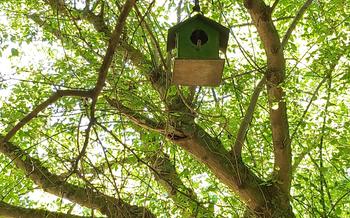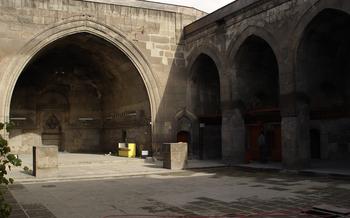
Gömeç Hatun Türbesi
- Gömeç Hatun Türbesi: A Mausoleum with a Rich the Gömeç Hatun Türbesi is a captivating 13th-century mausoleum that holds a significant place in the city's cultural tapestry. Its intricate tilework, octagonal shape, and elaborate portal are a testament to the artistry and craftsmanship of the Seljuk era. The türbe is dedicated to Gömeç Hatun, the daughter of a Seljuk ruler, whose tragic love story is deeply intertwined with the history of Kayseri. Discover the fascinating legend of Gömeç Hatun and immerse yourself in the historical context and cultural significance of this architectural marvel.
- Location and Accessibility
- Architectural Marvel
- Historical Significance
- Interior Beauty
- Cultural Importance
- Visiting Tips:
- Nearby Attractions
- Photography Opportunities
- Souvenirs and Handicrafts: Preserving Tradition through Local Craftsmanship
- Accommodation Options
- Accessibility for Disabled Visitors:
- Insider Tip:
Gömeç Hatun Türbesi: A Mausoleum with a Rich the Gömeç Hatun Türbesi is a captivating 13th-century mausoleum that holds a significant place in the city's cultural tapestry. Its intricate tilework, octagonal shape, and elaborate portal are a testament to the artistry and craftsmanship of the Seljuk era. The türbe is dedicated to Gömeç Hatun, the daughter of a Seljuk ruler, whose tragic love story is deeply intertwined with the history of Kayseri. Discover the fascinating legend of Gömeç Hatun and immerse yourself in the historical context and cultural significance of this architectural marvel.
Location and Accessibility
The Gömeç Hatun Türbesi is situated in the heart of Kayseri, a city steeped in history and culture. To reach the mausoleum, visitors can embark on a leisurely stroll from the city center, taking in the vibrant atmosphere and admiring the surrounding landmarks. The türbe is conveniently located within walking distance of several other notable attractions, including the Kayseri Castle and the Grand Mosque. Alternatively, visitors can opt for public transportation, with buses and trams regularly servicing the area. Taxis and rental cars are also readily available, offering a convenient and flexible option for those seeking a more personalized experience.
Architectural Marvel
The Gömeç Hatun Türbesi stands as a testament to the architectural prowess of the Seljuk dynasty. Its octagonal shape, a distinctive feature of Seljuk architecture, creates a harmonious and visually appealing form. The türbe's elaborate portal, intricately carved with geometric patterns and Kufic inscriptions, invites visitors into a realm of artistic excellence.
Inside, the türbe's interior reveals a serene and spiritual atmosphere. The walls and ceiling are adorned with exquisite tilework, featuring vibrant colors and intricate geometric designs. The mihrab, a niche indicating the direction of prayer, is a focal point of the türbe, showcasing intricate tilework and calligraphy. The cenotaph, a symbolic tomb representing Gömeç Hatun's resting place, is a simple yet elegant structure that adds to the türbe's solemn ambiance.
The Gömeç Hatun Türbesi's architectural features reflect the Seljuk dynasty's mastery of craftsmanship and their commitment to creating lasting monuments. Its unique design and exquisite ornamentation make it a must-visit for anyone interested in Islamic architecture and history.
Historical Significance
The Gömeç Hatun Türbesi stands as a testament to the grandeur and artistic prowess of the Seljuk dynasty, which ruled over much of Anatolia during the 11th to 13th centuries. Their reign left an indelible mark on Kayseri, transforming it into a thriving center of trade, culture, and Islamic architecture. The türbe is a prime example of Seljuk craftsmanship and artistic excellence, showcasing their mastery of intricate tilework, calligraphy, and geometric patterns.
Beyond its architectural significance, the Gömeç Hatun Türbesi holds immense historical value. It serves as a reminder of the Seljuk dynasty's contributions to the development of Turkish architecture and their role in shaping the cultural landscape of Kayseri. The türbe's location within the city's historical center further emphasizes its importance as a symbol of Kayseri's rich heritage.
The türbe's historical significance extends to its role in the local community. For generations, it has served as a place of pilgrimage and reverence for the people of Kayseri. The legend of Gömeç Hatun and her tragic love story has woven the türbe into the fabric of local folklore and traditions, making it an integral part of the city's cultural identity.
Interior Beauty
As you step inside the Gömeç Hatun Türbesi, a sense of serenity and spirituality envelops you. The interior is adorned with intricate tilework, calligraphy, and geometric patterns that create a visually stunning and awe-inspiring space. The walls and ceiling are covered in vibrant shades of blue, green, and gold, forming intricate designs that tell stories from Islamic history and mythology.
The mihrab, a niche in the wall indicating the direction of Mecca, is a masterpiece of craftsmanship. It is adorned with intricate tilework and calligraphy, creating a focal point for prayer and contemplation. The cenotaph, a symbolic tomb, is located in the center of the türbe and is believed to mark the resting place of Gömeç Hatun. It is covered with a rich red velvet cloth and surrounded by ornate metal railings.
The türbe has undergone extensive restoration efforts in recent years, meticulously preserving its original beauty and grandeur. These efforts have ensured that the Gömeç Hatun Türbesi remains a testament to the artistic and architectural achievements of the Seljuk dynasty and a symbol of Kayseri's rich cultural heritage.
Cultural Importance
The Gömeç Hatun Türbesi stands as a intricate tilework have made it a symbol of the city's cultural identity. The türbe attracts numerous visitors, both domestic and international, who come to admire its beauty and learn about its significance. Local organizations and communities play a crucial role in preserving and promoting the türbe's cultural value. They organize events and initiatives that aim to raise awareness about the türbe's history and its importance to the local community. Through these efforts, the Gömeç Hatun Türbesi continues to be a source of pride and inspiration for the people of Kayseri and a symbol of the city's rich cultural heritage.
Visiting Tips:
To fully appreciate the beauty of the Gömeç Hatun Türbesi and avoid the crowds, plan your visit for early morning or late afternoon. The türbe is open to the public daily during daylight hours, and there is no entrance fee. Dress modestly and respectfully, covering your shoulders and knees, as it is a religious site. To capture the most stunning photographs, use a tripod and wide-angle lens to capture the türbe's intricate details and grandeur. Take advantage of the golden hour during sunrise and sunset to capture the warm, ambient light that enhances the türbe's beauty.
Nearby Attractions
In the vicinity of the Gömeç Hatun Türbesi, visitors can embark on a journey of discovery through Kayseri's rich history and cultural heritage. A short stroll away lies the Kayseri Castle, an imposing fortress that has stood guard over the city for centuries. Explore its ramparts and towers, and let your imagination transport you back to a time of knights and chivalry.
Just a stone's throw from the castle, immerse yourself in the vibrant atmosphere of the Kayseri Bazaar, a bustling marketplace where you can haggle for traditional Turkish handicrafts, savor the aromas of local delicacies, and experience the warmth of Turkish hospitality.
For those seeking spiritual enlightenment, the Hunat Hatun Mosque, located a short walk from the türbe, offers a serene sanctuary. Admire its stunning architecture, intricate tilework, and peaceful ambiance, and take a moment to reflect on the city's deep-rooted religious traditions.
Art enthusiasts will delight in the Kayseri Museum, which houses an impressive collection of artifacts, paintings, and sculptures that showcase the city's artistic heritage. Immerse yourself in the vibrant colors and intricate designs of Anatolian carpets, marvel at the delicate brushstrokes of local painters, and gain insights into the creative spirit of Kayseri's artisans.
To satisfy your culinary cravings, venture into the narrow streets surrounding the Gömeç Hatun Türbesi, where you'll find an array of traditional Turkish restaurants serving mouthwatering kebabs, gözleme, and other local specialties. Indulge in the flavors of Kayseri's rich cuisine and savor the unique culinary experiences that this vibrant city has to offer.
Photography Opportunities
The Gömeç Hatun Türbesi offers a wealth of stunning photo opportunities for enthusiasts of all levels. Its unique architecture, intricate tilework, and serene atmosphere create a picturesque backdrop for capturing memorable images.
For the best results, consider using a tripod or wide-angle lens to capture the türbe's grandeur and intricate details. Experiment with different angles and perspectives to create dynamic compositions that showcase the mausoleum's beauty.
The türbe is particularly stunning during sunrise and sunset, when the warm, golden light casts a magical glow on its exterior. If you're an early riser or a sunset chaser, be sure to arrive at the türbe during these times to capture the most breathtaking shots.
Whether you're a professional photographer or simply a hobbyist with a passion for capturing beautiful moments, the Gömeç Hatun Türbesi is a must-visit destination for photography enthusiasts. So don't forget to bring your camera and capture the essence of this architectural gem.
Souvenirs and Handicrafts: Preserving Tradition through Local Craftsmanship
Kayseri is renowned for its vibrant local markets and shops, where visitors can immerse themselves in the city's rich tradition of handicrafts. From intricate carpets and vibrant pottery to exquisite jewelry and textiles, Kayseri's artisans showcase their mastery and dedication to preserving traditional craftsmanship.
The Kapalı Çarşı (Covered Market) is a must-visit for those seeking authentic souvenirs and handmade goods. This bustling marketplace offers a diverse array of traditional Turkish handicrafts, including carpets, kilims, copperware, and leather goods. Visitors can haggle with friendly vendors and discover unique treasures that reflect the city's cultural heritage.
For those seeking high-quality carpets, the Yahyalı district is a haven for carpet enthusiasts. Here, visitors can find an array of hand-woven carpets, each showcasing intricate designs and vibrant colors. The Ahi Evran Museum also houses a collection of antique carpets, offering visitors a glimpse into the history and artistry of Turkish carpet weaving.
Jewelry lovers should head to the Sarraflar Çarşısı (Goldsmiths' Market), where they can find an array of gold and silver jewelry, handcrafted with meticulous attention to detail. From delicate necklaces and earrings to ornate bracelets and rings, the Sarraflar Çarşısı offers a treasure trove of unique pieces that embody Turkish craftsmanship.
Supporting local artisans and preserving traditional crafts is essential to maintaining Kayseri's cultural identity. By purchasing souvenirs and handicrafts from local markets and shops, visitors not only take home a piece of Kayseri's heritage but also contribute to the livelihoods of talented artisans who keep these traditions alive.
Accommodation Options
Kayseri offers a diverse range of accommodation options to suit every budget and preference. From budget-friendly guesthouses to luxurious hotels, visitors can find a comfortable place to stay near the Gömeç Hatun Türbesi and other attractions.
For those seeking a budget-friendly option, there are several guesthouses and hostels located within walking distance of the türbe. These guesthouses offer basic yet comfortable accommodations, often with shared facilities.
For a more luxurious experience, visitors can choose from a range of upscale hotels in Kayseri. These hotels offer modern amenities, spacious rooms, and convenient access to the city's attractions.
If you prefer a unique and authentic experience, consider staying in a traditional Turkish guesthouse or "han." These guesthouses offer a glimpse into Turkish culture and hospitality, with charming rooms and communal spaces where guests can interact with locals.
To ensure a hassle-free stay, it is advisable to book your accommodation in advance, especially during peak tourist season. Online booking platforms and travel agents can assist you in finding the best deals and availability.
Accessibility for Disabled Visitors:
The Gömeç Hatun Türbesi is committed to providing an accessible and welcoming environment for all visitors, regardless of their abilities. The türbe features ramps and designated parking spaces for wheelchair users, ensuring easy access to the site. Visitors with impaired mobility can also request assistance from the türbe's friendly staff, who are always ready to provide support and guidance. To ensure a seamless experience, it is advisable for visitors with specific accessibility needs to contact the türbe's administration in advance, allowing the staff to make necessary arrangements and provide any additional assistance required.
Insider Tip:
For a unique perspective of the Gömeç Hatun Türbesi and the surrounding cityscape, climb to the rooftop terrace of the nearby Hüdavendigar Mosque. This hidden gem offers panoramic views that will leave you breathless. Capture stunning photographs of the türbe's intricate architecture set against the backdrop of the Kayseri skyline. Enjoy a moment of tranquility as you soak in the beauty of this historic city from a bird's-eye view.









